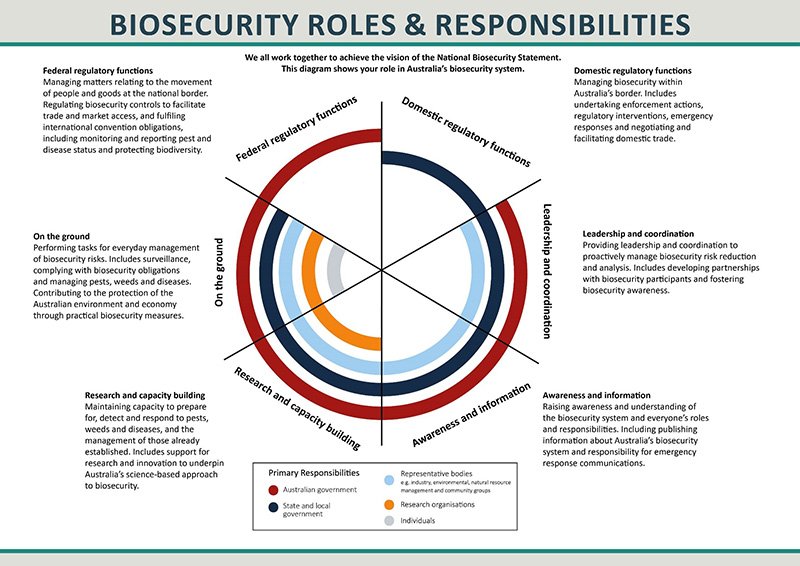The National Biosecurity Statement presents a shared vision for Australia’s biosecurity.
Developed by a working group of industry and environmental groups and government, the statement sets out:
- a national vision and goals
- clear roles and responsibilities
- priorities and principles for managing biosecurity risk.
The working group presented the final National Biosecurity Statement at the 2018 National Biosecurity Forum in November 2018.
Download
| Document | Pages | File size |
|---|---|---|
National Biosecurity Statement PDF  |
2 | 4 MB |
If you have difficulty accessing this file, please visit web accessibility.
Online version
Nature makes Australia unique – biosecurity keeps it that way.
Biosecurity protects Australian livelihoods and is vital to strengthening and supporting our environment and economy, including tourism, trade and agriculture. It underpins many aspects of our way of life.
Australia prides itself on its unique natural environment, high-quality produce and trusted international reputation. We Australians benefit from this and have a duty to protect our land and seas from the arrival of new pests, weeds and diseases.
We are also obliged to limit the damaging and costly impacts of the pests, weeds and diseases already here and to avoid adding to that burden.
Our biosecurity system works both at the border and here at home to prevent and respond to the arrival and spread of harmful pests and diseases that could disrupt much of what we love about this country.
Due to our clean and green reputation we are regarded as a responsible and reliable trading nation. Strong biosecurity measures help us to continue to grow safe and sought-after Australian produce for ourselves and the rest of the world.
The arrival and spread of damaging invasive species could have wide-ranging short- and long-term consequences for industry, land use and community needs.
A single incursion could harm human health and the environmental resources we all need and use—including water supply, soil and ecosystems.
Australia’s national biosecurity system relies on partnerships between the Australian and state, territory and local governments, industry, environmental bodies, land managers and the broader public. This system is facing new challenges arising from a significant increase in global trade and travel.
Maintaining Australia’s resilient and world-leading approach requires continuous research and innovation and a constant commitment to prevention and response.
What you can do
Each one of us has a role to play in keeping Australia safe from harmful pests and diseases.
- If you see something unusual, report it.
- Know your legal responsibilities when travelling and moving goods.
- Recognise your role in promoting and raising awareness of biosecurity.
Everyone can share the vision of an effective and sustainable national biosecurity system. We should:
- strive for prevention and early action to ensure a very low risk of new harmful pests and diseases entering, establishing and spreading.
- minimise the impact of established pests and diseases on our environment, economy, industries and communities.
- maintain and grow domestic and international travel and trade access.
- protect and restore Australia’s unique biodiversity, ecosystems, natural resources and landscapes.
We all share the risks. We all share the benefits. We must all share the responsibility of protecting our unique natural environment.
Biosecurity roles and responsibilities

History
The 2017 Priorities for Australia’s Biosecurity System review report noted there was no overarching shared national policy statement or strategy. The report recommended the National Biosecurity Committee develop a national biosecurity statement through an open, transparent and collaborative process.
A working group was formed to develop the statement. Members of the National Biosecurity Statement working group include:
- Grain Producers Australia
- AUSVEG
- Victorian Farmers Federation Horticulture Group
- NSW Farmers Association
- Australian Pork Ltd
- National Farmers’ Federation
- Agriculture Victoria
- Plant Biosecurity Research Initiative
- Wool Producers Australia
- Invasive Species Council
- Australasian Weed Society.
The working group met throughout 2018 to produce a draft statement which was open for comment from 7 June to 31 October 2018 through the Have your say website. Community, industry, environmental and government interests made submissions. Further feedback was received through the 2018 state and territory biosecurity roundtables and forums held by Plant Health Australia and Animal Health Australia. The final National Biosecurity Statement was presented to stakeholders at the National Biosecurity Forum on 29 November 2018.
National Biosecurity Communication and Engagement Strategy
View the National Biosecurity Communication and Engagement Strategy.
